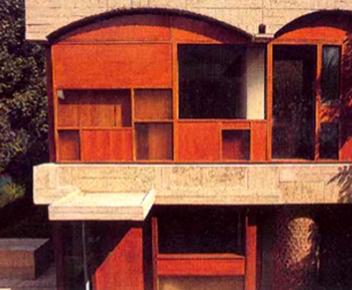The fragmented opening [095]
The traditional window used to be vertically fragmented in superposed elements so as to specialize the filter of each segment. Normally the highest parts were light collectors with no protection. The intermediate parts had all kinds of filters, and sometimes also lower parts had different filters from the rest. The Canary window [075] and this monumental window in Oporto [166] are extreme examples of that fragmentation.
Towards the middle of last century that fragmentation was recovered in projects such as the Eames House [573], the Maisons Jaoul [609] or the Esherick House by Louis Khan [031].
Today, this resource is increasingly used to enhance the chances of filters, as in some Murcutt’s works [161] [022] or in different kind of intermediate spaces [566].
But nowadays, probably the most significant example is in the modern "integrated" light facade of office buildings. Here the segments resulting of vertical and horizontal fragmentation can locate various types of holes or accommodate different climate control systems [084] [131].



![/photo/fanlight-oporto-166 Link: Fanlight in Oporto [166]](https://www.filt3rs.net/sites/default/files/styles/entity_ref/public/study/1b%20166%20Oporto%20fragmented%20opening%20window%20contraventana%20celos%C3%ADa%20lattice%20wooden%20madera%20abatible%20pivoting_0.jpg?itok=4JwusRNE)
![/case/fragmented-eames-house-573 Link: The fragmented Eames House [573]](https://www.filt3rs.net/sites/default/files/styles/entity_ref/public/study/2a%20fragmented%20opening%20curtain%20cortina%20interior%20ph1%20case%20study%20house%208%20eames%20los%20angeles_0.jpg?itok=utSVzXqi)
![/case/best-le-corbusiers-design-openings-and-protections-609 Link: The best Le Corbusier’s design of openings and protections [609]](https://www.filt3rs.net/sites/default/files/styles/entity_ref/public/study/2b%20fragmented%20opening%20wood%20madera%20contraventana%20shutter%201_maison_jaoul_corbusier_neuilly_sur_seine_0.jpg?itok=VuMWzqxc)
![/photo/huecos-fragmentados-en-la-casa-esherick Fragmented windows in Esherick House [031]](https://www.filt3rs.net/sites/default/files/styles/entity_ref/public/study/2c%20fragmented%20opening%20shutter%20contraventa%20wooden%20madera%20esherick_0.jpg?itok=MatBlB42)
![/case/fragmented-window-riversdale-glenn-murcutt-161 Link: Fragmented window in Riversdale, Glenn Murcutt [161]](https://www.filt3rs.net/sites/default/files/styles/entity_ref/public/study/3a%201_Glenn_Murcutt_Reg_Lark_Wendy_Lewin_Arthur_Yvonne_Boyd_Art_Centre_Riversdale_West_Cambewarra_0.jpg?itok=XUFOL43X)

![/case/fragmented-enclosure-566 Link: A fragmented enclosure [566]](https://www.filt3rs.net/sites/default/files/styles/entity_ref/public/study/3c%20fragmented%20opening%20terrace%20panels%20wood%20madera%20terraza%20cubierta%202275252_orig%20architectureps_0.jpg?itok=uH3hvU2V)
![/case/fragmented-window-i-module-dusseldorf-131 Link: Fragmented window \"i-module\" in Düsseldorf [131]](https://www.filt3rs.net/sites/default/files/styles/entity_ref/public/study/4b%20fragmented%20opening%20fachada%20oficina%20fragmentada%20ventilaci%C3%B3n%20lamas%20ventilation%20louvers%20detall%20fa%C3%A7ana%20copy_0.jpg?itok=9m8d0hbU)